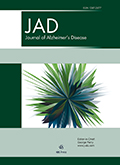Authors: Zhai, Weijie | Zhao, Anguo | Wei, Chunxiao | Xu, Yanjiao | Cui, Xinran | Zhang, Yan | Meng, Lingjie | Sun, Li
Article Type:
Research Article
Abstract:
Background: Although observational studies indicated connections between fatty acids (FAs) and Alzheimer’s disease and dementia, uncertainty persists regarding how these relationships extend to dementia with Lewy bodies (DLB). Objective: To explore the potential causal relationships between FAs and the development of DLB, thus clarifying these associations using genetic instruments to infer causality. Methods: We applied a two-sample Mendelian randomization (MR) and multivariable Mendelian randomization (MVMR) approach. Genetic data were obtained from a DLB cohort, comprising 2,591 cases and 4,027 controls of European descent. Eight FAs, including linoleic acid, docosahexaenoic acid, monounsaturated fatty acid, omega-3 fatty acid,
…omega-6 fatty acid, polyunsaturated fatty acid, saturated fatty acid, and total fatty acid, were procured from a comprehensive GWAS of metabolic biomarkers of UK Biobank, conducted by Nightingale Health in 2020 (met-d), involving 114,999 individuals. Our analysis included inverse-variance weighted, MR-Egger, weighted-median, simple mode, and weighted-mode MR estimates. Cochran’s Q-statistics, MR-PRESSO, and MR-Egger intercept test were used to quantify the heterogeneity and horizontal pleiotropy of instrumental variables. Results: Only linoleic acid showed a significant genetic association with the risk of developing DLB in the univariate MR. The odds ratio for linoleic acid was 1.337 with a 95% confidence interval of 1.019–1.756 (pIVW = 0.036). Results from the MVMR showed that no FAs were associated with the incidence of DLB. Conclusions: The results did not support the hypothesis that FAs could reduce the risk of developing DLB. However, elucidating the relationship between FAs and DLB risk holds potential implications for informing dietary recommendations and therapeutic approaches in DLB.
Show more
Keywords: Alzheimer’s disease, dementia, dementia with Lewy bodies, fatty acids, linoleic acid, Mendelian randomization
DOI: 10.3233/JAD-240267
Citation: Journal of Alzheimer's Disease,
vol. Pre-press, no. Pre-press, pp. 1-15, 2024
Price: EUR 27.50





